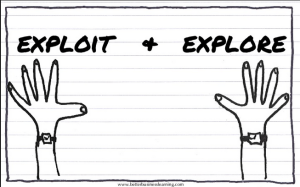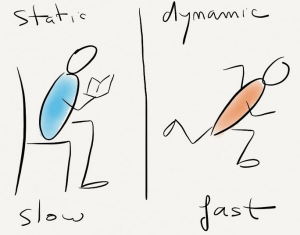 Do we know what are the dependencies and requirements for building and sustaining your organizations innovation success?
Do we know what are the dependencies and requirements for building and sustaining your organizations innovation success?
How do you sustain innovation, is it more through the structuring of everyday work, by creating a particular set of social rules and resources that foster specific routines? Or something different?
We work really hard at maintaining these re-occurring processes, never willing to extend and push them in different and new ways. We have actually become very static in our approaches and learning, we are not learning anew.
We often simply end up with incremental innovation that might just ‘nudge’ the growth needle but does little more than sustain us in the present and can be ‘contained’ in a tidy process that makes many, including the ‘bean counters,’ very happy until someone changes the game.
Then we need to think differently but this is usually far too late.. As demand is more volatile today we need to experiment, explore, learn and adjust. What becomes more important is the ‘work to be done, and how we go about tackling this and not the work done where we often simply ‘default too. Surprisingly Adam Smith identified this important difference in work way back in 1776.
This can be explained as the ‘work done’ is the accumulated knowledge, which has built up and been embodied in the firms results with the innovations achieved in the past and is seen as the tangible capital that we continue to leverage..
The work to be done is how well it can adapt to change or what needs to be brought in to help in this new work. In the past century we operated in mass production era, with systems with standard goods and stable market conditions the ‘work done’ was equivalent to the ‘work to be done’.
In today’s global market, with its rapid technology diffusion, disruptive and constant change, with an emphasis on serving the ‘work to be done’ as more important than the ‘work done’ and identifying and growing our intangible assets are fundamental to this. This is where we need a more radical, evolving innovation set of capabilities to push our business growth beyond the normal.
Work to be done is the need for our future growth and well-being to be derived through innovation activities. These are so much made up of intangible parts, the growing innovation capital, that will provide the new wealth of organizations in the knowledge sharing economy of today and the near future.
Certainly I buy the argument that Innovation should become part of everyone’s job on a daily basis so they have the space and potential to work on it constantly but what does this require? This is part of our journey within seeking innovation fitness through its dynamics.
Part of our innovation debate is what is “dynamic” or “routine” for managing future innovation success?
For me the argument points to the capacity to build “dynamic capabilities for innovation” around the critical situation we are all finding ourselves in, that we are all in an age of rapid ongoing change.
‘Rapid change’ calls for constantly developing and leveraging new understanding, building knowledge that is based on dynamic capabilities, it evolves and changes all the time. These need to be fully understood so the appropriate resource and commitment can be placed behind them.
The world of innovation is based on something that is very clear: it is consistently changing and challenging, has never-ending competition, a constant price/performance rivalry, increasing quest for improving returns and the ‘creative destruction’ of existing competencies all certainly contribute to rapid change no doubt.
This is a highly dynamic environment we are all living and operating in today. Are you building those skills and capabilities to adapt and react?
Building new capabilities or stuck in the past?
Are our organizations building the capabilities to become highly dynamic or are they stuck in the past, looking for routine and repeating established procedures expecting these to get them through this volatile world? They will find this path of repeating established practices like the one to their own demise and eventual destruction.
What are the firm-specific capabilities that can be sources of real evolving but equally lasting advantage? How can combinations of competencies and resources be developed, deployed, nurtured and protected? These need to be difficult-to-imitate combinations and integrative enough to give new sources of competitive advantage to stimulate new growth and financial return.
In my work, I have spent considerable time investigating what makes up the dynamics that accelerate our abilities to innovate in better ways, so it sustains and equally evolves to ‘battle’ the increasing volatility we will be facing on an ongoing basis. These
Strategic innovation often changes the ‘game’; what it explores and exploits to stay dynamic.
Firstly we need to go back and understand “What are dynamic capabilities?
 Dynamic capabilities are those skills, processes, routines, organizational structures and disciplines to build, employ and orchestrate intangible assets that are not replicated easily by others and constantly change to meet customers’ needs.
Dynamic capabilities are those skills, processes, routines, organizational structures and disciplines to build, employ and orchestrate intangible assets that are not replicated easily by others and constantly change to meet customers’ needs.
Dynamic Innovation Capabilities need to advance knowledge creation and absorption, extend and integrate what is learnt into something more worthwhile, something new. These capabilities need to learn how to modify constantly the way we operate, reconfigure and redeploy.
This involves the dynamic of sensing, seizing and transforming (Teece et.all) at the three interdependent levels of the individual, firm and network to coordinate/ integrate, learn and transform constantly and to reflect the constant change that is taking place.
Two different academic views but does one lead to the other?
Dynamic Capabilities are defined by Teece, Pisano & Shuen in their different papers on the subject as “the firm’s ability to integrate, build and reconfigure internal and external competencies to address rapidly changing environments so as to achieve new and innovative forms of competitive advantage”.
Everyday Dynamics are where people know what is expected of them and what to expect from others and have a common ground for negotiating collective action in particular situations that create an ongoing social fabric where innovation naturally flows. Zollo & Winter suggest a dynamic capability “is a learned and stable pattern of collective activity through which the organization systematically generates and modifies its operating routines in pursuit of improved effectiveness”
Both definitions require learning through equally exploiting and exploring
Both of these ‘dynamics’ arise from learning and this within organizations more likely to come from systematic methods. Innovation nearly always requires structure, process and being worked through in systematic ways unless you perhaps are a sole inventor/ innovator.
To work with others successfully you need a certain structure, a process and a given environment and culture to deliver innovation.
We have to realize that capabilities for innovation are complex, they are structured and multi-dimensional.
Often today organizations strive to keep these far too much in “equilibrium” (zero level) but the reality is that our markets being served are not in this ‘equilibrium’ and are constantly being disruptive, more ‘dynamic’ than ever. We cannot keep a ‘business as usual’ mindset we need to recognize we are operating in a potential set of constantly unstable circumstances. Business is a complex adaptive affair.
We need to become far more aware of the dynamics that surround us that are needed for innovation to work constantly. We need our journey to evolve.
2 thoughts on “Building the new dynamics into our capacity to innovate”
Comments are closed.